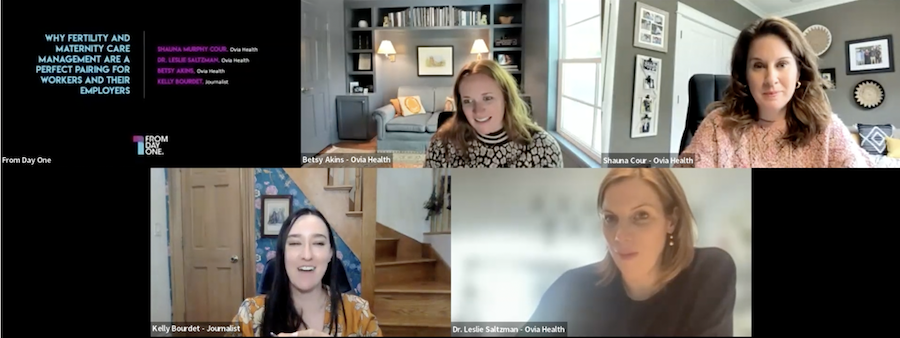Holistic Wellness for Women: Supporting Health in Every Life Phase


When Shauna Murphy Cour, the vice president of employer sales at Ovia Health, had her three kids, she was working for a tech company. From the outside, it looked like she had all the right benefits to support her journey through pregnancy and early motherhood.
“I had 20 weeks paid leave, but the culture, at the time, had me sneak out of the back door [for family obligations and for doctors’ visits], I’d be pumping in the storage closet,” she told journalist Kelly Bourdet during a From Day One webinar on fertility and parental benefits titled “Why Fertility and Maternity Care Management Are a Perfect Pairing for Workers and Their Employers.”
And while stigma for conditions such as mental health and fertility issues has decreased, the truth is that many still consider women’s health a niche benefit, even though it’s an extremely vast industry with different goals and facets. In the case of fertility, there is an overall lack of awareness on the matter, which is a missed opportunity in terms of proactive family planning and early detection.
A platform like Ovia, a maternity and family-planning benefits solution for employers and health plans, allows patients to explore all paths to parenthood, including ART, adoption, and the collaboration with a gestational carrier. That’s where Cour eventually landed, and she currently leads Ovia’s sales team. “I was fed up with the lack of focus on women’s health.”
A Proactive Approach, Before the Family-planning Stage
Ovia’s platform includes preventive care, such as preservation, but it can also include the diagnosis and treatment of infertility. “In terms of treatment, most of us think of IVF, but there’s also medical treatments: drugs, IUI, it can also include donor sperm for male infertility, which involves 30% of infertility cases,” says Dr. Leslie Saltzman, Ovia’s chief medical officer.
Other benefits also include gestational carrier services. That’s the competitive advantage of a platform like Ovia, an exclusive focus on fertility care as opposed to preventive care and assistance through early parenthood lacks understanding of what can happen downstream. “The thing about fertility service is that there’s all types of data: all types of medically assisted reproduction, including taking medicines, make pregnancies higher risk,” says Saltzman.
It’s not an assessment based on gestational age, but it’s the result of the comparison of an unassisted vs an assisted pregnancy among women of the same age. Other higher-risk factors include: multiple gestation, preterm birth, preeclampsia, abruption, and C-section delivery. “We also see other types of risk factors: Black women using ART have higher rates of infant mortality,” continues Dr. Saltzman.

Still, it all starts with preventive care and a proactive approach to reproductive health. “We’d prefer that a person with PCOS and endometriosis be diagnosed earlier, so they can learn how to best maximize their chances,” she explains. “And because these pregnancies are higher-risk, it’s good to have the resources.” Such an approach will, ideally, avoid using unnecessary technology, and prevent high-cost outcomes because people are supported through their pregnancy.
Support in All Stages of Life
“What happens, often, is that when you try to get pregnant, you try to jump into the deep end,” says Cour. “By that point, you should have been monitoring for many years, and we have women starting at age 18.” On the other end of the spectrum, last year Ovia added perimenopause focused care, which has historically been massively underserved, both in terms of research and science. “Like many things, we’re told to muscle through it,” says Cour. “That’s where we have people come in. We understand where they’re at, what they’re looking for. We’re that source that’s there.”
This also means supporting patients in their day-to-day management of their fertility and family-planning journey. “It can feel dark and isolating, but after a few appointments, appointments happen very frequently,” says Betsy Akins, Ovia’s VP of client success. “It’s all based on your ultrasound schedule, and when you’re attending with someone else, it’s also difficult for their schedule.” This means it’s also important to be empowered to learn what benefits are readily available: sometimes you’re unaware that you have, say, 10 free sessions of therapy, or mental-health screenings. And, ideally, when people are aware of their suit of benefit, they can help their coworkers, by pointing out something that they were unaware of.
Benefits as a Catalyst for Gender Equity in the Workplace
Making fertility benefits accessible is essential. Especially in an era where women’s representation in the workforce is lower than in the 1980s. “Now it’s about DEI and retaining talent: how do you make it real, so that’s tangible and quantifiable?” Cour asks rhetorically. That’s when fertility and family-planning benefits become huge: women start trying later, and might want to freeze their eggs to keep options open. “Having alternative pathways has become such an important benefit,” she says.
Editor's note: From Day One thanks our partner, Ovia Health, for sponsoring this webinar.
Angelica Frey is a writer and a translator based in Boston and Milan.
The From Day One Newsletter is a monthly roundup of articles, features, and editorials on innovative ways for companies to forge stronger relationships with their employees, customers, and communities.